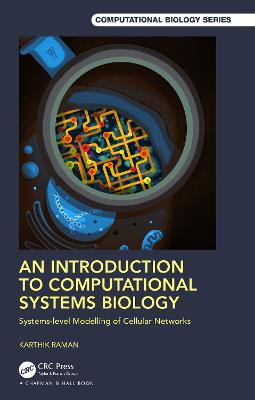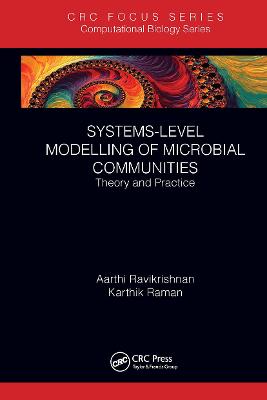Introduction to Computational Systems Biology
 -10%
portes grátis
-10%
portes grátis
Introduction to Computational Systems Biology
Systems-Level Modelling of Cellular Networks
Raman, Karthik
Taylor & Francis Ltd
05/2021
358
Dura
Inglês
9781138597327
15 a 20 dias
820
Descrição não disponível.
Preface
Introduction to modelling
1.1 WHAT IS MODELLING?
1.1.1 What are models?
1.2 WHYBUILD MODELS?
1.2.1 Why model biological systems?
1.2.2 Why systems biology?
1.3 CHALLENGES IN MODELLING BIOLOGICAL SYSTEMS
1.4 THE PRACTICE OF MODELLING
1.4.1 Scope of the model
1.4.2 Making assumptions
1.4.3 Modelling paradigms
1.4.4 Building the model
1.4.5 Model analysis, debugging and (in)validation
1.4.6 Simulating the model
1.5 EXAMPLES OF MODELS
1.5.1 Lotka-Volterra predator-prey model
1.5.2 SIR model: a classic example
1.6 TROUBLESHOOTING
1.6.1 Clarity of scope and objectives
1.6.2 The breakdown of assumptions
1.6.3 Ismy model fit for purpose?
1.6.4 Handling uncertainties
EXERCISES
REFERENCES
FURTHER READING
Introduction to graph theory
2.1 BASICS
2.1.1 History of graph theory
2.1.2 Examples of graphs
2.2 WHYGRAPHS?
2.3 TYPES OF GRAPHS
2.3.1 Simple vs. non-simple graphs
2.3.2 Directed vs. undirected graphs
2.3.3 Weighted vs. unweighted graphs
2.3.4 Other graph types
2.3.5 Hypergraphs
2.4 COMPUTATIONAL REPRESENTATIONS OF GRAPHS
2.4.1 Data structures
2.4.2 Adjacency matrix
2.4.3 The laplacian matrix
2.5 GRAPH REPRESENTATIONS OF BIOLOGICAL NETWORKS
2.5.1 Networks of protein interactions and functional associations
2.5.2 Signalling networks
2.5.3 Protein structure networks
2.5.4 Gene regulatory networks
2.5.5 Metabolic networks
2.6 COMMONCHALLENGES&TROUBLESHOOTING
2.6.1 Choosing a representation
2.6.2 Loading and creating graphs
2.7 SOFTWARE TOOLS
EXERCISES
REFERENCES
FURTHER READING
Structure of networks
3.1 NETWORK PARAMETERS
3.1.1 Fundamental parameters
3.1.2 Measures of centrality
3.1.3 Mixing patterns: assortativity
3.2 CANONICAL NETWORK MODELS
3.2.1 Erdos-Renyi (ER) network model
3.2.2 Small-world networks
3.2.3 Scale-free networks
3.2.4 Other models of network generation
3.3 COMMUNITY DETECTION
3.3.1 Modularity maximisation
3.3.2 Similarity-based clustering
3.3.3 Girvan-Newman algorithm
3.3.4 Other methods
3.3.5 Community detection in biological networks
3.4 NETWORKMOTIFS
3.4.1 Randomising networks
3.5 PERTURBATIONS TO NETWORKS
3.5.1 Quantifying e?fects of perturbation
3.5.2 Network structure and attack strategies
3.6 TROUBLESHOOTING
3.6.1 Is your network really scale-free?
3.7 SOFTWARE TOOLS
EXERCISES
REFERENCES
FURTHER READING
Applications of network biology
4.1 THE CENTRALITY-LETHALITY HYPOTHESIS
4.1.1 Predicting essential genes fromnetworks
4.2 NETWORKS AND MODULES IN DISEASE
4.2.1 Disease networks
4.2.2 Identification of disease modules
4.2.3 Edgetic perturbation models
4.3 DIFFERENTIAL NETWORK ANALYSIS
4.4 DISEASE SPREADING ON NETWORKS
4.4.1 Percolation-based models
4.4.2 Agent-based simulations
4.5 MOLECULAR GRAPHS AND THEIR APPLICATIONS
4.5.1 Retrosynthesis
4.6 PROTEIN STRUCTURE, ENERGY & CONFORMATIONAL NETWORKS
4.6.1 Protein folding pathways
4.7 LINK PREDICTION
EXERCISES
REFERENCES
FURTHER READING
Introduction to dynamic modelling
5.1 CONSTRUCTING DYNAMIC MODELS
5.1.1 Modelling a generic biochemical system
5.2 MASS-ACTION KINETIC MODELS
5.3 MODELLING ENZYME KINETICS
5.3.1 The Michaelis-Menten model
5.3.2 Extending the Michaelis-Menten model
5.3.3 Limitations of Michaelis-Menten models
5.3.4 Co-operativity: Hill kinetics
5.3.5 An illustrative example: a three-node oscillator
5.4 GENERALISED RATE EQUATIONS
5.4.1 Biochemical systems theory
5.5 SOLVING ODES
5.6 TROUBLESHOOTING
5.6.1 Handing sti?f equations
5.6.2 Handling uncertainty
5.7 SOFTWARE TOOLS
EXERCISES
REFERENCES
FURTHER READING
Parameter estimation
6.1 DATA-DRIVEN MECHANISTIC MODELLING: AN OVERVIEW
6.1.1 Pre-processing the data
6.1.2 Model identification
6.2 SETTING UP AN OPTIMISATION PROBLEM
6.2.1 Linear regression
6.2.2 Least squares
6.2.3 Maximumlikelihood estimation
6.3 ALGORITHMS FOR OPTIMISATION
6.3.1 Desiderata
6.3.2 Gradient-based methods
6.3.3 Direct search methods
6.3.4 Evolutionary algorithms
6.4 POST-REGRESSION DIAGNOSTICS
6.4.1 Model selection
6.4.2 Sensitivity and robustness of biological models
6.5 TROUBLESHOOTING
6.5.1 Regularisation
6.5.2 Sloppiness
6.5.3 Choosing a search algorithm
6.5.4 Model reduction
6.5.5 The curse of dimensionality
6.6 SOFTWARE TOOLS
EXERCISES
REFERENCES
FURTHER READING
Discrete dynamic models: Boolean networks
7.1 INTRODUCTION
7.2 BOOLEAN NETWORKS: TRANSFER FUNCTIONS
7.2.1 Characterising Boolean network dynamics
7.2.2 Synchronous vs. asynchronous updates
7.3 OTHER PARADIGMS
7.3.1 Probabilistic Boolean networks
7.3.2 Logical interaction hypergraphs
7.3.3 Generalised logical networks
7.3.4 Petri nets
7.4 APPLICATIONS
7.5 TROUBLESHOOTING
7.6 SOFTWARE TOOLS
EXERCISES
REFERENCES
FURTHER READING
Introduction to constraint-based modelling
8.1 WHAT ARE CONSTRAINTS?
8.1.1 Types of constraints
8.1.2 Mathematical representation of constraints
8.1.3 Why are constraints useful?
8.2 THE STOICHIOMETRICMATRIX
8.3 STEADY-STATEMASSBALANCE:FLUXBALANCEANALYSIS (FBA)
8.4 THE OBJECTIVE FUNCTION
8.4.1 The biomass objective function
8.5 OPTIMISATION TO COMPUTE FLUX DISTRIBUTION
8.6 AN ILLUSTRATION
8.7 FLUX VARIABILITY ANALYSIS (FVA)
8.8 UNDERSTANDING FBA
8.8.1 Blocked reactions and dead-end metabolites
8.8.2 Gaps in metabolic networks
8.8.3 Multiple solutions
8.8.4 Loops
8.8.5 Parsimonious FBA (pFBA)
8.8.6 ATP maintenance fluxes
8.9 TROUBLESHOOTING
8.9.1 Zero growth rate
8.9.2 Objective values vs. flux values
8.10 SOFTWARE TOOLS
EXERCISES
REFERENCES
FURTHER READING
Extending constraint-based approaches
9.1 MINIMISATION OF METABOLIC ADJUSTMENT (MOMA)
9.1.1 Fitting experimentally measured fluxes
9.2 REGULATORY ON-OFF MINIMISATION (ROOM)
9.2.1 ROOMvs.MoMA
9.3 BI-LEVEL OPTIMISATIONS
9.3.1 OptKnock
9.4 INTEGRATING REGULATORY INFORMATION
9.4.1 Embedding regulatory logic: regulatory FBA (rFBA)
9.4.2 Informing metabolic models with omic data
9.4.3 Tissue-specific models
9.5 COMPARTMENTALISED MODELS
9.6 DYNAMIC FLUX BALANCE ANALYSIS (dFBA)
9.7 13C-MFA
9.8 ELEMENTARY FLUX MODES AND EXTREME PATHWAYS
9.8.1 Computing EFMs and EPs
9.8.2 Applications
EXERCISES
REFERENCES
FURTHER READING
Perturbations to metabolic networks
10.1 KNOCK-OUTS
10.1.1 Gene deletions vs. reaction deletions
10.2 SYNTHETIC LETHALS
10.2.1 Exhaustive enumeration
10.2.2 Bi-level optimisation
10.2.3 Fast-SL: massively pruning the search space
10.3 OVER-EXPRESSION
10.3.1 Flux Scanning based on Enforced Objective Flux (FSEOF)
10.4 OTHER PERTURBATIONS
10.5 EVALUATING AND RANKING PERTURBATIONS
10.6 APPLICATIONS OF CONSTRAINT-BASED MODELS
10.6.1 Metabolic engineering
10.6.2 Drug target identification
10.7 LIMITATIONS OF CONSTRAINT-BASED APPROACHES
10.7.1 Scope of genome-scale metabolic models
10.7.2 Incorrect predictions
10.8 TROUBLESHOOTING
10.8.1 Interpreting gene deletion simulations
10.9 SOFTWARE TOOLS
EXERCISES
REFERENCES
FURTHER READING
Modelling cellular interactions
11.1 MICROBIAL COMMUNITIES
11.1.1 Network-based approaches
11.1.2 Population-based and agent-based approaches
11.1.3 Constraint-based approaches
11.2 HOST-PATHOGEN INTERACTIONS (HPIs)
11.2.1 Network models
11.2.2 Dynamic models
11.2.3 Constraint-based models
11.3 SUMMARY
11.4 SOFTWARE TOOLS
EXERCISES
REFERENCES
FURTHER READING
Designing biological circuits
12.1 WHAT IS SYNTHETIC BIOLOGY?
12.2 FROMLEGO BRICKS TO BIOBRICKS
12.3 CLASSIC CIRCUIT DESIGN EXPERIMENTS
12.3.1 Designing an oscillator: the repressilator
12.3.2 Toggle switch
12.4 DESIGNING MODULES
12.4.1 Exploring the design space
12.4.2 Systems-theoretic approaches
12.4.3 Automating circuit design
12.5 DESIGN PRINCIPLES OF BIOLOGICAL NETWORKS
12.5.1 Redundancy
12.5.2 Modularity
12.5.3 Exaptation
12.5.4 Robustness
12.6 COMPUTING WITH CELLS
12.6.1 Adleman's classic experiment
12.6.2 Examples of circuits that can compute
12.6.3 DNA data storage
12.7 CHALLENGES
12.8 SOFTWARE TOOLS
EXERCISES
REFERENCES
FURTHER READING
Robustness and evolvability of biological systems
13.1 ROBUSTNESS IN BIOLOGICAL SYSTEMS
13.1.1 Key mechanisms
13.1.2 Hierarchies and protocols
13.1.3 Organising principles
13.2 GENOTYPE SPACES AND GENOTYPE NETWORKS
13.2.1 Genotype spaces
13.2.2 Genotype-phenotype mapping
13.3 QUANTIFYING ROBUSTNESS AND EVOLVABILITY
13.4 SOFTWARE TOOLS
EXERCISES
REFERENCES
FURTHER READING
Epilogue: The Road Ahead
Index 325
Introduction to modelling
1.1 WHAT IS MODELLING?
1.1.1 What are models?
1.2 WHYBUILD MODELS?
1.2.1 Why model biological systems?
1.2.2 Why systems biology?
1.3 CHALLENGES IN MODELLING BIOLOGICAL SYSTEMS
1.4 THE PRACTICE OF MODELLING
1.4.1 Scope of the model
1.4.2 Making assumptions
1.4.3 Modelling paradigms
1.4.4 Building the model
1.4.5 Model analysis, debugging and (in)validation
1.4.6 Simulating the model
1.5 EXAMPLES OF MODELS
1.5.1 Lotka-Volterra predator-prey model
1.5.2 SIR model: a classic example
1.6 TROUBLESHOOTING
1.6.1 Clarity of scope and objectives
1.6.2 The breakdown of assumptions
1.6.3 Ismy model fit for purpose?
1.6.4 Handling uncertainties
EXERCISES
REFERENCES
FURTHER READING
Introduction to graph theory
2.1 BASICS
2.1.1 History of graph theory
2.1.2 Examples of graphs
2.2 WHYGRAPHS?
2.3 TYPES OF GRAPHS
2.3.1 Simple vs. non-simple graphs
2.3.2 Directed vs. undirected graphs
2.3.3 Weighted vs. unweighted graphs
2.3.4 Other graph types
2.3.5 Hypergraphs
2.4 COMPUTATIONAL REPRESENTATIONS OF GRAPHS
2.4.1 Data structures
2.4.2 Adjacency matrix
2.4.3 The laplacian matrix
2.5 GRAPH REPRESENTATIONS OF BIOLOGICAL NETWORKS
2.5.1 Networks of protein interactions and functional associations
2.5.2 Signalling networks
2.5.3 Protein structure networks
2.5.4 Gene regulatory networks
2.5.5 Metabolic networks
2.6 COMMONCHALLENGES&TROUBLESHOOTING
2.6.1 Choosing a representation
2.6.2 Loading and creating graphs
2.7 SOFTWARE TOOLS
EXERCISES
REFERENCES
FURTHER READING
Structure of networks
3.1 NETWORK PARAMETERS
3.1.1 Fundamental parameters
3.1.2 Measures of centrality
3.1.3 Mixing patterns: assortativity
3.2 CANONICAL NETWORK MODELS
3.2.1 Erdos-Renyi (ER) network model
3.2.2 Small-world networks
3.2.3 Scale-free networks
3.2.4 Other models of network generation
3.3 COMMUNITY DETECTION
3.3.1 Modularity maximisation
3.3.2 Similarity-based clustering
3.3.3 Girvan-Newman algorithm
3.3.4 Other methods
3.3.5 Community detection in biological networks
3.4 NETWORKMOTIFS
3.4.1 Randomising networks
3.5 PERTURBATIONS TO NETWORKS
3.5.1 Quantifying e?fects of perturbation
3.5.2 Network structure and attack strategies
3.6 TROUBLESHOOTING
3.6.1 Is your network really scale-free?
3.7 SOFTWARE TOOLS
EXERCISES
REFERENCES
FURTHER READING
Applications of network biology
4.1 THE CENTRALITY-LETHALITY HYPOTHESIS
4.1.1 Predicting essential genes fromnetworks
4.2 NETWORKS AND MODULES IN DISEASE
4.2.1 Disease networks
4.2.2 Identification of disease modules
4.2.3 Edgetic perturbation models
4.3 DIFFERENTIAL NETWORK ANALYSIS
4.4 DISEASE SPREADING ON NETWORKS
4.4.1 Percolation-based models
4.4.2 Agent-based simulations
4.5 MOLECULAR GRAPHS AND THEIR APPLICATIONS
4.5.1 Retrosynthesis
4.6 PROTEIN STRUCTURE, ENERGY & CONFORMATIONAL NETWORKS
4.6.1 Protein folding pathways
4.7 LINK PREDICTION
EXERCISES
REFERENCES
FURTHER READING
Introduction to dynamic modelling
5.1 CONSTRUCTING DYNAMIC MODELS
5.1.1 Modelling a generic biochemical system
5.2 MASS-ACTION KINETIC MODELS
5.3 MODELLING ENZYME KINETICS
5.3.1 The Michaelis-Menten model
5.3.2 Extending the Michaelis-Menten model
5.3.3 Limitations of Michaelis-Menten models
5.3.4 Co-operativity: Hill kinetics
5.3.5 An illustrative example: a three-node oscillator
5.4 GENERALISED RATE EQUATIONS
5.4.1 Biochemical systems theory
5.5 SOLVING ODES
5.6 TROUBLESHOOTING
5.6.1 Handing sti?f equations
5.6.2 Handling uncertainty
5.7 SOFTWARE TOOLS
EXERCISES
REFERENCES
FURTHER READING
Parameter estimation
6.1 DATA-DRIVEN MECHANISTIC MODELLING: AN OVERVIEW
6.1.1 Pre-processing the data
6.1.2 Model identification
6.2 SETTING UP AN OPTIMISATION PROBLEM
6.2.1 Linear regression
6.2.2 Least squares
6.2.3 Maximumlikelihood estimation
6.3 ALGORITHMS FOR OPTIMISATION
6.3.1 Desiderata
6.3.2 Gradient-based methods
6.3.3 Direct search methods
6.3.4 Evolutionary algorithms
6.4 POST-REGRESSION DIAGNOSTICS
6.4.1 Model selection
6.4.2 Sensitivity and robustness of biological models
6.5 TROUBLESHOOTING
6.5.1 Regularisation
6.5.2 Sloppiness
6.5.3 Choosing a search algorithm
6.5.4 Model reduction
6.5.5 The curse of dimensionality
6.6 SOFTWARE TOOLS
EXERCISES
REFERENCES
FURTHER READING
Discrete dynamic models: Boolean networks
7.1 INTRODUCTION
7.2 BOOLEAN NETWORKS: TRANSFER FUNCTIONS
7.2.1 Characterising Boolean network dynamics
7.2.2 Synchronous vs. asynchronous updates
7.3 OTHER PARADIGMS
7.3.1 Probabilistic Boolean networks
7.3.2 Logical interaction hypergraphs
7.3.3 Generalised logical networks
7.3.4 Petri nets
7.4 APPLICATIONS
7.5 TROUBLESHOOTING
7.6 SOFTWARE TOOLS
EXERCISES
REFERENCES
FURTHER READING
Introduction to constraint-based modelling
8.1 WHAT ARE CONSTRAINTS?
8.1.1 Types of constraints
8.1.2 Mathematical representation of constraints
8.1.3 Why are constraints useful?
8.2 THE STOICHIOMETRICMATRIX
8.3 STEADY-STATEMASSBALANCE:FLUXBALANCEANALYSIS (FBA)
8.4 THE OBJECTIVE FUNCTION
8.4.1 The biomass objective function
8.5 OPTIMISATION TO COMPUTE FLUX DISTRIBUTION
8.6 AN ILLUSTRATION
8.7 FLUX VARIABILITY ANALYSIS (FVA)
8.8 UNDERSTANDING FBA
8.8.1 Blocked reactions and dead-end metabolites
8.8.2 Gaps in metabolic networks
8.8.3 Multiple solutions
8.8.4 Loops
8.8.5 Parsimonious FBA (pFBA)
8.8.6 ATP maintenance fluxes
8.9 TROUBLESHOOTING
8.9.1 Zero growth rate
8.9.2 Objective values vs. flux values
8.10 SOFTWARE TOOLS
EXERCISES
REFERENCES
FURTHER READING
Extending constraint-based approaches
9.1 MINIMISATION OF METABOLIC ADJUSTMENT (MOMA)
9.1.1 Fitting experimentally measured fluxes
9.2 REGULATORY ON-OFF MINIMISATION (ROOM)
9.2.1 ROOMvs.MoMA
9.3 BI-LEVEL OPTIMISATIONS
9.3.1 OptKnock
9.4 INTEGRATING REGULATORY INFORMATION
9.4.1 Embedding regulatory logic: regulatory FBA (rFBA)
9.4.2 Informing metabolic models with omic data
9.4.3 Tissue-specific models
9.5 COMPARTMENTALISED MODELS
9.6 DYNAMIC FLUX BALANCE ANALYSIS (dFBA)
9.7 13C-MFA
9.8 ELEMENTARY FLUX MODES AND EXTREME PATHWAYS
9.8.1 Computing EFMs and EPs
9.8.2 Applications
EXERCISES
REFERENCES
FURTHER READING
Perturbations to metabolic networks
10.1 KNOCK-OUTS
10.1.1 Gene deletions vs. reaction deletions
10.2 SYNTHETIC LETHALS
10.2.1 Exhaustive enumeration
10.2.2 Bi-level optimisation
10.2.3 Fast-SL: massively pruning the search space
10.3 OVER-EXPRESSION
10.3.1 Flux Scanning based on Enforced Objective Flux (FSEOF)
10.4 OTHER PERTURBATIONS
10.5 EVALUATING AND RANKING PERTURBATIONS
10.6 APPLICATIONS OF CONSTRAINT-BASED MODELS
10.6.1 Metabolic engineering
10.6.2 Drug target identification
10.7 LIMITATIONS OF CONSTRAINT-BASED APPROACHES
10.7.1 Scope of genome-scale metabolic models
10.7.2 Incorrect predictions
10.8 TROUBLESHOOTING
10.8.1 Interpreting gene deletion simulations
10.9 SOFTWARE TOOLS
EXERCISES
REFERENCES
FURTHER READING
Modelling cellular interactions
11.1 MICROBIAL COMMUNITIES
11.1.1 Network-based approaches
11.1.2 Population-based and agent-based approaches
11.1.3 Constraint-based approaches
11.2 HOST-PATHOGEN INTERACTIONS (HPIs)
11.2.1 Network models
11.2.2 Dynamic models
11.2.3 Constraint-based models
11.3 SUMMARY
11.4 SOFTWARE TOOLS
EXERCISES
REFERENCES
FURTHER READING
Designing biological circuits
12.1 WHAT IS SYNTHETIC BIOLOGY?
12.2 FROMLEGO BRICKS TO BIOBRICKS
12.3 CLASSIC CIRCUIT DESIGN EXPERIMENTS
12.3.1 Designing an oscillator: the repressilator
12.3.2 Toggle switch
12.4 DESIGNING MODULES
12.4.1 Exploring the design space
12.4.2 Systems-theoretic approaches
12.4.3 Automating circuit design
12.5 DESIGN PRINCIPLES OF BIOLOGICAL NETWORKS
12.5.1 Redundancy
12.5.2 Modularity
12.5.3 Exaptation
12.5.4 Robustness
12.6 COMPUTING WITH CELLS
12.6.1 Adleman's classic experiment
12.6.2 Examples of circuits that can compute
12.6.3 DNA data storage
12.7 CHALLENGES
12.8 SOFTWARE TOOLS
EXERCISES
REFERENCES
FURTHER READING
Robustness and evolvability of biological systems
13.1 ROBUSTNESS IN BIOLOGICAL SYSTEMS
13.1.1 Key mechanisms
13.1.2 Hierarchies and protocols
13.1.3 Organising principles
13.2 GENOTYPE SPACES AND GENOTYPE NETWORKS
13.2.1 Genotype spaces
13.2.2 Genotype-phenotype mapping
13.3 QUANTIFYING ROBUSTNESS AND EVOLVABILITY
13.4 SOFTWARE TOOLS
EXERCISES
REFERENCES
FURTHER READING
Epilogue: The Road Ahead
Index 325
Este título pertence ao(s) assunto(s) indicados(s). Para ver outros títulos clique no assunto desejado.
Metabolic Networks;biological networks;String Database;network biology;National Academy;synthetic biology;Synthetic Lethals;Biological systems;Metabolic Model;Community modelling;Boolean Network;Constraint-based models;Mathematical modelling approaches;Genome Scale Metabolic Models;Computational systems biology;Sir Model;Bipartite Graph;Protein Protein Interaction Networks;Adjacency Matrix;Systems Biology;Gene Network;Protein Interaction Network;Systems Level Modelling;Constraint Based Modelling;Petri Nets;Stoichiometric Matrix;Genotype Space;Bi-level Optimisation Problem;Discrete Dynamic Models;Degree Distribution;Neutral Network
Preface
Introduction to modelling
1.1 WHAT IS MODELLING?
1.1.1 What are models?
1.2 WHYBUILD MODELS?
1.2.1 Why model biological systems?
1.2.2 Why systems biology?
1.3 CHALLENGES IN MODELLING BIOLOGICAL SYSTEMS
1.4 THE PRACTICE OF MODELLING
1.4.1 Scope of the model
1.4.2 Making assumptions
1.4.3 Modelling paradigms
1.4.4 Building the model
1.4.5 Model analysis, debugging and (in)validation
1.4.6 Simulating the model
1.5 EXAMPLES OF MODELS
1.5.1 Lotka-Volterra predator-prey model
1.5.2 SIR model: a classic example
1.6 TROUBLESHOOTING
1.6.1 Clarity of scope and objectives
1.6.2 The breakdown of assumptions
1.6.3 Ismy model fit for purpose?
1.6.4 Handling uncertainties
EXERCISES
REFERENCES
FURTHER READING
Introduction to graph theory
2.1 BASICS
2.1.1 History of graph theory
2.1.2 Examples of graphs
2.2 WHYGRAPHS?
2.3 TYPES OF GRAPHS
2.3.1 Simple vs. non-simple graphs
2.3.2 Directed vs. undirected graphs
2.3.3 Weighted vs. unweighted graphs
2.3.4 Other graph types
2.3.5 Hypergraphs
2.4 COMPUTATIONAL REPRESENTATIONS OF GRAPHS
2.4.1 Data structures
2.4.2 Adjacency matrix
2.4.3 The laplacian matrix
2.5 GRAPH REPRESENTATIONS OF BIOLOGICAL NETWORKS
2.5.1 Networks of protein interactions and functional associations
2.5.2 Signalling networks
2.5.3 Protein structure networks
2.5.4 Gene regulatory networks
2.5.5 Metabolic networks
2.6 COMMONCHALLENGES&TROUBLESHOOTING
2.6.1 Choosing a representation
2.6.2 Loading and creating graphs
2.7 SOFTWARE TOOLS
EXERCISES
REFERENCES
FURTHER READING
Structure of networks
3.1 NETWORK PARAMETERS
3.1.1 Fundamental parameters
3.1.2 Measures of centrality
3.1.3 Mixing patterns: assortativity
3.2 CANONICAL NETWORK MODELS
3.2.1 Erdos-Renyi (ER) network model
3.2.2 Small-world networks
3.2.3 Scale-free networks
3.2.4 Other models of network generation
3.3 COMMUNITY DETECTION
3.3.1 Modularity maximisation
3.3.2 Similarity-based clustering
3.3.3 Girvan-Newman algorithm
3.3.4 Other methods
3.3.5 Community detection in biological networks
3.4 NETWORKMOTIFS
3.4.1 Randomising networks
3.5 PERTURBATIONS TO NETWORKS
3.5.1 Quantifying e?fects of perturbation
3.5.2 Network structure and attack strategies
3.6 TROUBLESHOOTING
3.6.1 Is your network really scale-free?
3.7 SOFTWARE TOOLS
EXERCISES
REFERENCES
FURTHER READING
Applications of network biology
4.1 THE CENTRALITY-LETHALITY HYPOTHESIS
4.1.1 Predicting essential genes fromnetworks
4.2 NETWORKS AND MODULES IN DISEASE
4.2.1 Disease networks
4.2.2 Identification of disease modules
4.2.3 Edgetic perturbation models
4.3 DIFFERENTIAL NETWORK ANALYSIS
4.4 DISEASE SPREADING ON NETWORKS
4.4.1 Percolation-based models
4.4.2 Agent-based simulations
4.5 MOLECULAR GRAPHS AND THEIR APPLICATIONS
4.5.1 Retrosynthesis
4.6 PROTEIN STRUCTURE, ENERGY & CONFORMATIONAL NETWORKS
4.6.1 Protein folding pathways
4.7 LINK PREDICTION
EXERCISES
REFERENCES
FURTHER READING
Introduction to dynamic modelling
5.1 CONSTRUCTING DYNAMIC MODELS
5.1.1 Modelling a generic biochemical system
5.2 MASS-ACTION KINETIC MODELS
5.3 MODELLING ENZYME KINETICS
5.3.1 The Michaelis-Menten model
5.3.2 Extending the Michaelis-Menten model
5.3.3 Limitations of Michaelis-Menten models
5.3.4 Co-operativity: Hill kinetics
5.3.5 An illustrative example: a three-node oscillator
5.4 GENERALISED RATE EQUATIONS
5.4.1 Biochemical systems theory
5.5 SOLVING ODES
5.6 TROUBLESHOOTING
5.6.1 Handing sti?f equations
5.6.2 Handling uncertainty
5.7 SOFTWARE TOOLS
EXERCISES
REFERENCES
FURTHER READING
Parameter estimation
6.1 DATA-DRIVEN MECHANISTIC MODELLING: AN OVERVIEW
6.1.1 Pre-processing the data
6.1.2 Model identification
6.2 SETTING UP AN OPTIMISATION PROBLEM
6.2.1 Linear regression
6.2.2 Least squares
6.2.3 Maximumlikelihood estimation
6.3 ALGORITHMS FOR OPTIMISATION
6.3.1 Desiderata
6.3.2 Gradient-based methods
6.3.3 Direct search methods
6.3.4 Evolutionary algorithms
6.4 POST-REGRESSION DIAGNOSTICS
6.4.1 Model selection
6.4.2 Sensitivity and robustness of biological models
6.5 TROUBLESHOOTING
6.5.1 Regularisation
6.5.2 Sloppiness
6.5.3 Choosing a search algorithm
6.5.4 Model reduction
6.5.5 The curse of dimensionality
6.6 SOFTWARE TOOLS
EXERCISES
REFERENCES
FURTHER READING
Discrete dynamic models: Boolean networks
7.1 INTRODUCTION
7.2 BOOLEAN NETWORKS: TRANSFER FUNCTIONS
7.2.1 Characterising Boolean network dynamics
7.2.2 Synchronous vs. asynchronous updates
7.3 OTHER PARADIGMS
7.3.1 Probabilistic Boolean networks
7.3.2 Logical interaction hypergraphs
7.3.3 Generalised logical networks
7.3.4 Petri nets
7.4 APPLICATIONS
7.5 TROUBLESHOOTING
7.6 SOFTWARE TOOLS
EXERCISES
REFERENCES
FURTHER READING
Introduction to constraint-based modelling
8.1 WHAT ARE CONSTRAINTS?
8.1.1 Types of constraints
8.1.2 Mathematical representation of constraints
8.1.3 Why are constraints useful?
8.2 THE STOICHIOMETRICMATRIX
8.3 STEADY-STATEMASSBALANCE:FLUXBALANCEANALYSIS (FBA)
8.4 THE OBJECTIVE FUNCTION
8.4.1 The biomass objective function
8.5 OPTIMISATION TO COMPUTE FLUX DISTRIBUTION
8.6 AN ILLUSTRATION
8.7 FLUX VARIABILITY ANALYSIS (FVA)
8.8 UNDERSTANDING FBA
8.8.1 Blocked reactions and dead-end metabolites
8.8.2 Gaps in metabolic networks
8.8.3 Multiple solutions
8.8.4 Loops
8.8.5 Parsimonious FBA (pFBA)
8.8.6 ATP maintenance fluxes
8.9 TROUBLESHOOTING
8.9.1 Zero growth rate
8.9.2 Objective values vs. flux values
8.10 SOFTWARE TOOLS
EXERCISES
REFERENCES
FURTHER READING
Extending constraint-based approaches
9.1 MINIMISATION OF METABOLIC ADJUSTMENT (MOMA)
9.1.1 Fitting experimentally measured fluxes
9.2 REGULATORY ON-OFF MINIMISATION (ROOM)
9.2.1 ROOMvs.MoMA
9.3 BI-LEVEL OPTIMISATIONS
9.3.1 OptKnock
9.4 INTEGRATING REGULATORY INFORMATION
9.4.1 Embedding regulatory logic: regulatory FBA (rFBA)
9.4.2 Informing metabolic models with omic data
9.4.3 Tissue-specific models
9.5 COMPARTMENTALISED MODELS
9.6 DYNAMIC FLUX BALANCE ANALYSIS (dFBA)
9.7 13C-MFA
9.8 ELEMENTARY FLUX MODES AND EXTREME PATHWAYS
9.8.1 Computing EFMs and EPs
9.8.2 Applications
EXERCISES
REFERENCES
FURTHER READING
Perturbations to metabolic networks
10.1 KNOCK-OUTS
10.1.1 Gene deletions vs. reaction deletions
10.2 SYNTHETIC LETHALS
10.2.1 Exhaustive enumeration
10.2.2 Bi-level optimisation
10.2.3 Fast-SL: massively pruning the search space
10.3 OVER-EXPRESSION
10.3.1 Flux Scanning based on Enforced Objective Flux (FSEOF)
10.4 OTHER PERTURBATIONS
10.5 EVALUATING AND RANKING PERTURBATIONS
10.6 APPLICATIONS OF CONSTRAINT-BASED MODELS
10.6.1 Metabolic engineering
10.6.2 Drug target identification
10.7 LIMITATIONS OF CONSTRAINT-BASED APPROACHES
10.7.1 Scope of genome-scale metabolic models
10.7.2 Incorrect predictions
10.8 TROUBLESHOOTING
10.8.1 Interpreting gene deletion simulations
10.9 SOFTWARE TOOLS
EXERCISES
REFERENCES
FURTHER READING
Modelling cellular interactions
11.1 MICROBIAL COMMUNITIES
11.1.1 Network-based approaches
11.1.2 Population-based and agent-based approaches
11.1.3 Constraint-based approaches
11.2 HOST-PATHOGEN INTERACTIONS (HPIs)
11.2.1 Network models
11.2.2 Dynamic models
11.2.3 Constraint-based models
11.3 SUMMARY
11.4 SOFTWARE TOOLS
EXERCISES
REFERENCES
FURTHER READING
Designing biological circuits
12.1 WHAT IS SYNTHETIC BIOLOGY?
12.2 FROMLEGO BRICKS TO BIOBRICKS
12.3 CLASSIC CIRCUIT DESIGN EXPERIMENTS
12.3.1 Designing an oscillator: the repressilator
12.3.2 Toggle switch
12.4 DESIGNING MODULES
12.4.1 Exploring the design space
12.4.2 Systems-theoretic approaches
12.4.3 Automating circuit design
12.5 DESIGN PRINCIPLES OF BIOLOGICAL NETWORKS
12.5.1 Redundancy
12.5.2 Modularity
12.5.3 Exaptation
12.5.4 Robustness
12.6 COMPUTING WITH CELLS
12.6.1 Adleman's classic experiment
12.6.2 Examples of circuits that can compute
12.6.3 DNA data storage
12.7 CHALLENGES
12.8 SOFTWARE TOOLS
EXERCISES
REFERENCES
FURTHER READING
Robustness and evolvability of biological systems
13.1 ROBUSTNESS IN BIOLOGICAL SYSTEMS
13.1.1 Key mechanisms
13.1.2 Hierarchies and protocols
13.1.3 Organising principles
13.2 GENOTYPE SPACES AND GENOTYPE NETWORKS
13.2.1 Genotype spaces
13.2.2 Genotype-phenotype mapping
13.3 QUANTIFYING ROBUSTNESS AND EVOLVABILITY
13.4 SOFTWARE TOOLS
EXERCISES
REFERENCES
FURTHER READING
Epilogue: The Road Ahead
Index 325
Introduction to modelling
1.1 WHAT IS MODELLING?
1.1.1 What are models?
1.2 WHYBUILD MODELS?
1.2.1 Why model biological systems?
1.2.2 Why systems biology?
1.3 CHALLENGES IN MODELLING BIOLOGICAL SYSTEMS
1.4 THE PRACTICE OF MODELLING
1.4.1 Scope of the model
1.4.2 Making assumptions
1.4.3 Modelling paradigms
1.4.4 Building the model
1.4.5 Model analysis, debugging and (in)validation
1.4.6 Simulating the model
1.5 EXAMPLES OF MODELS
1.5.1 Lotka-Volterra predator-prey model
1.5.2 SIR model: a classic example
1.6 TROUBLESHOOTING
1.6.1 Clarity of scope and objectives
1.6.2 The breakdown of assumptions
1.6.3 Ismy model fit for purpose?
1.6.4 Handling uncertainties
EXERCISES
REFERENCES
FURTHER READING
Introduction to graph theory
2.1 BASICS
2.1.1 History of graph theory
2.1.2 Examples of graphs
2.2 WHYGRAPHS?
2.3 TYPES OF GRAPHS
2.3.1 Simple vs. non-simple graphs
2.3.2 Directed vs. undirected graphs
2.3.3 Weighted vs. unweighted graphs
2.3.4 Other graph types
2.3.5 Hypergraphs
2.4 COMPUTATIONAL REPRESENTATIONS OF GRAPHS
2.4.1 Data structures
2.4.2 Adjacency matrix
2.4.3 The laplacian matrix
2.5 GRAPH REPRESENTATIONS OF BIOLOGICAL NETWORKS
2.5.1 Networks of protein interactions and functional associations
2.5.2 Signalling networks
2.5.3 Protein structure networks
2.5.4 Gene regulatory networks
2.5.5 Metabolic networks
2.6 COMMONCHALLENGES&TROUBLESHOOTING
2.6.1 Choosing a representation
2.6.2 Loading and creating graphs
2.7 SOFTWARE TOOLS
EXERCISES
REFERENCES
FURTHER READING
Structure of networks
3.1 NETWORK PARAMETERS
3.1.1 Fundamental parameters
3.1.2 Measures of centrality
3.1.3 Mixing patterns: assortativity
3.2 CANONICAL NETWORK MODELS
3.2.1 Erdos-Renyi (ER) network model
3.2.2 Small-world networks
3.2.3 Scale-free networks
3.2.4 Other models of network generation
3.3 COMMUNITY DETECTION
3.3.1 Modularity maximisation
3.3.2 Similarity-based clustering
3.3.3 Girvan-Newman algorithm
3.3.4 Other methods
3.3.5 Community detection in biological networks
3.4 NETWORKMOTIFS
3.4.1 Randomising networks
3.5 PERTURBATIONS TO NETWORKS
3.5.1 Quantifying e?fects of perturbation
3.5.2 Network structure and attack strategies
3.6 TROUBLESHOOTING
3.6.1 Is your network really scale-free?
3.7 SOFTWARE TOOLS
EXERCISES
REFERENCES
FURTHER READING
Applications of network biology
4.1 THE CENTRALITY-LETHALITY HYPOTHESIS
4.1.1 Predicting essential genes fromnetworks
4.2 NETWORKS AND MODULES IN DISEASE
4.2.1 Disease networks
4.2.2 Identification of disease modules
4.2.3 Edgetic perturbation models
4.3 DIFFERENTIAL NETWORK ANALYSIS
4.4 DISEASE SPREADING ON NETWORKS
4.4.1 Percolation-based models
4.4.2 Agent-based simulations
4.5 MOLECULAR GRAPHS AND THEIR APPLICATIONS
4.5.1 Retrosynthesis
4.6 PROTEIN STRUCTURE, ENERGY & CONFORMATIONAL NETWORKS
4.6.1 Protein folding pathways
4.7 LINK PREDICTION
EXERCISES
REFERENCES
FURTHER READING
Introduction to dynamic modelling
5.1 CONSTRUCTING DYNAMIC MODELS
5.1.1 Modelling a generic biochemical system
5.2 MASS-ACTION KINETIC MODELS
5.3 MODELLING ENZYME KINETICS
5.3.1 The Michaelis-Menten model
5.3.2 Extending the Michaelis-Menten model
5.3.3 Limitations of Michaelis-Menten models
5.3.4 Co-operativity: Hill kinetics
5.3.5 An illustrative example: a three-node oscillator
5.4 GENERALISED RATE EQUATIONS
5.4.1 Biochemical systems theory
5.5 SOLVING ODES
5.6 TROUBLESHOOTING
5.6.1 Handing sti?f equations
5.6.2 Handling uncertainty
5.7 SOFTWARE TOOLS
EXERCISES
REFERENCES
FURTHER READING
Parameter estimation
6.1 DATA-DRIVEN MECHANISTIC MODELLING: AN OVERVIEW
6.1.1 Pre-processing the data
6.1.2 Model identification
6.2 SETTING UP AN OPTIMISATION PROBLEM
6.2.1 Linear regression
6.2.2 Least squares
6.2.3 Maximumlikelihood estimation
6.3 ALGORITHMS FOR OPTIMISATION
6.3.1 Desiderata
6.3.2 Gradient-based methods
6.3.3 Direct search methods
6.3.4 Evolutionary algorithms
6.4 POST-REGRESSION DIAGNOSTICS
6.4.1 Model selection
6.4.2 Sensitivity and robustness of biological models
6.5 TROUBLESHOOTING
6.5.1 Regularisation
6.5.2 Sloppiness
6.5.3 Choosing a search algorithm
6.5.4 Model reduction
6.5.5 The curse of dimensionality
6.6 SOFTWARE TOOLS
EXERCISES
REFERENCES
FURTHER READING
Discrete dynamic models: Boolean networks
7.1 INTRODUCTION
7.2 BOOLEAN NETWORKS: TRANSFER FUNCTIONS
7.2.1 Characterising Boolean network dynamics
7.2.2 Synchronous vs. asynchronous updates
7.3 OTHER PARADIGMS
7.3.1 Probabilistic Boolean networks
7.3.2 Logical interaction hypergraphs
7.3.3 Generalised logical networks
7.3.4 Petri nets
7.4 APPLICATIONS
7.5 TROUBLESHOOTING
7.6 SOFTWARE TOOLS
EXERCISES
REFERENCES
FURTHER READING
Introduction to constraint-based modelling
8.1 WHAT ARE CONSTRAINTS?
8.1.1 Types of constraints
8.1.2 Mathematical representation of constraints
8.1.3 Why are constraints useful?
8.2 THE STOICHIOMETRICMATRIX
8.3 STEADY-STATEMASSBALANCE:FLUXBALANCEANALYSIS (FBA)
8.4 THE OBJECTIVE FUNCTION
8.4.1 The biomass objective function
8.5 OPTIMISATION TO COMPUTE FLUX DISTRIBUTION
8.6 AN ILLUSTRATION
8.7 FLUX VARIABILITY ANALYSIS (FVA)
8.8 UNDERSTANDING FBA
8.8.1 Blocked reactions and dead-end metabolites
8.8.2 Gaps in metabolic networks
8.8.3 Multiple solutions
8.8.4 Loops
8.8.5 Parsimonious FBA (pFBA)
8.8.6 ATP maintenance fluxes
8.9 TROUBLESHOOTING
8.9.1 Zero growth rate
8.9.2 Objective values vs. flux values
8.10 SOFTWARE TOOLS
EXERCISES
REFERENCES
FURTHER READING
Extending constraint-based approaches
9.1 MINIMISATION OF METABOLIC ADJUSTMENT (MOMA)
9.1.1 Fitting experimentally measured fluxes
9.2 REGULATORY ON-OFF MINIMISATION (ROOM)
9.2.1 ROOMvs.MoMA
9.3 BI-LEVEL OPTIMISATIONS
9.3.1 OptKnock
9.4 INTEGRATING REGULATORY INFORMATION
9.4.1 Embedding regulatory logic: regulatory FBA (rFBA)
9.4.2 Informing metabolic models with omic data
9.4.3 Tissue-specific models
9.5 COMPARTMENTALISED MODELS
9.6 DYNAMIC FLUX BALANCE ANALYSIS (dFBA)
9.7 13C-MFA
9.8 ELEMENTARY FLUX MODES AND EXTREME PATHWAYS
9.8.1 Computing EFMs and EPs
9.8.2 Applications
EXERCISES
REFERENCES
FURTHER READING
Perturbations to metabolic networks
10.1 KNOCK-OUTS
10.1.1 Gene deletions vs. reaction deletions
10.2 SYNTHETIC LETHALS
10.2.1 Exhaustive enumeration
10.2.2 Bi-level optimisation
10.2.3 Fast-SL: massively pruning the search space
10.3 OVER-EXPRESSION
10.3.1 Flux Scanning based on Enforced Objective Flux (FSEOF)
10.4 OTHER PERTURBATIONS
10.5 EVALUATING AND RANKING PERTURBATIONS
10.6 APPLICATIONS OF CONSTRAINT-BASED MODELS
10.6.1 Metabolic engineering
10.6.2 Drug target identification
10.7 LIMITATIONS OF CONSTRAINT-BASED APPROACHES
10.7.1 Scope of genome-scale metabolic models
10.7.2 Incorrect predictions
10.8 TROUBLESHOOTING
10.8.1 Interpreting gene deletion simulations
10.9 SOFTWARE TOOLS
EXERCISES
REFERENCES
FURTHER READING
Modelling cellular interactions
11.1 MICROBIAL COMMUNITIES
11.1.1 Network-based approaches
11.1.2 Population-based and agent-based approaches
11.1.3 Constraint-based approaches
11.2 HOST-PATHOGEN INTERACTIONS (HPIs)
11.2.1 Network models
11.2.2 Dynamic models
11.2.3 Constraint-based models
11.3 SUMMARY
11.4 SOFTWARE TOOLS
EXERCISES
REFERENCES
FURTHER READING
Designing biological circuits
12.1 WHAT IS SYNTHETIC BIOLOGY?
12.2 FROMLEGO BRICKS TO BIOBRICKS
12.3 CLASSIC CIRCUIT DESIGN EXPERIMENTS
12.3.1 Designing an oscillator: the repressilator
12.3.2 Toggle switch
12.4 DESIGNING MODULES
12.4.1 Exploring the design space
12.4.2 Systems-theoretic approaches
12.4.3 Automating circuit design
12.5 DESIGN PRINCIPLES OF BIOLOGICAL NETWORKS
12.5.1 Redundancy
12.5.2 Modularity
12.5.3 Exaptation
12.5.4 Robustness
12.6 COMPUTING WITH CELLS
12.6.1 Adleman's classic experiment
12.6.2 Examples of circuits that can compute
12.6.3 DNA data storage
12.7 CHALLENGES
12.8 SOFTWARE TOOLS
EXERCISES
REFERENCES
FURTHER READING
Robustness and evolvability of biological systems
13.1 ROBUSTNESS IN BIOLOGICAL SYSTEMS
13.1.1 Key mechanisms
13.1.2 Hierarchies and protocols
13.1.3 Organising principles
13.2 GENOTYPE SPACES AND GENOTYPE NETWORKS
13.2.1 Genotype spaces
13.2.2 Genotype-phenotype mapping
13.3 QUANTIFYING ROBUSTNESS AND EVOLVABILITY
13.4 SOFTWARE TOOLS
EXERCISES
REFERENCES
FURTHER READING
Epilogue: The Road Ahead
Index 325
Este título pertence ao(s) assunto(s) indicados(s). Para ver outros títulos clique no assunto desejado.
Metabolic Networks;biological networks;String Database;network biology;National Academy;synthetic biology;Synthetic Lethals;Biological systems;Metabolic Model;Community modelling;Boolean Network;Constraint-based models;Mathematical modelling approaches;Genome Scale Metabolic Models;Computational systems biology;Sir Model;Bipartite Graph;Protein Protein Interaction Networks;Adjacency Matrix;Systems Biology;Gene Network;Protein Interaction Network;Systems Level Modelling;Constraint Based Modelling;Petri Nets;Stoichiometric Matrix;Genotype Space;Bi-level Optimisation Problem;Discrete Dynamic Models;Degree Distribution;Neutral Network







